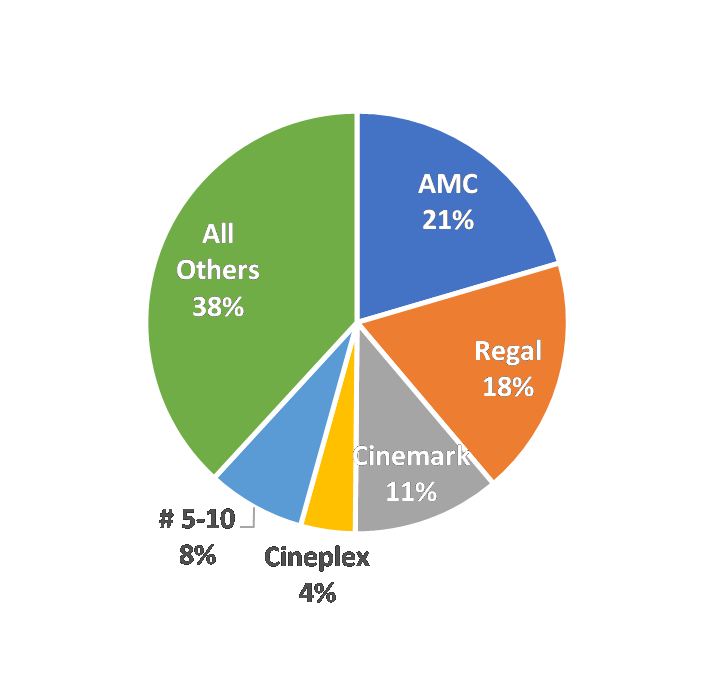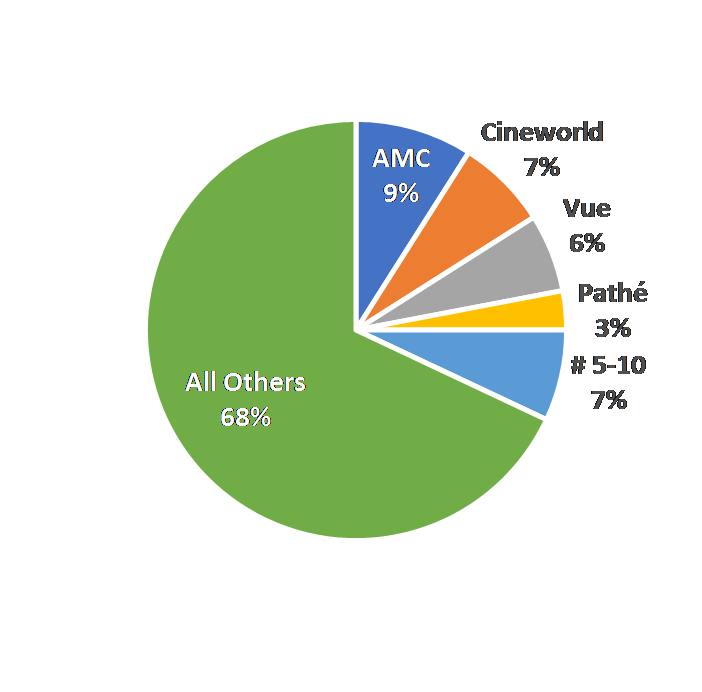Digital Content Delivery – Can AMC Theatres survive?

Digital content delivery of various forms of entertainment has created a trail of casualties. Will AMC be next?
Movie theater ticket sales in the United States and Canada have decreased by 16% in the last 15 years despite steady population growth in both countries (Exhibit 1). This decline in admissions has been partially offset by the rise in average ticket prices primarily due to premium large format screens (IMAX, Dolby, etc.) and premium seating (recliner seats at newly renovated theaters). However, movie studios are becoming increasingly concerned with the trends and are looking for new ways of increasing revenues [1].
Exhibit 1: Annual U.S./Canada Admissions (ticket sales in billions) [2]
Premium Video-on-Demand (“PVOD”) has become the vessel by which movie studios can capture a greater percentage of the sales generated by the movies they produce and attract new customers who hate going to movie theaters because of the hassle, but who forget to purchase the films 3 to 6 months later when they are finally released for home-viewing purchase. With PVOD, consumers would pay $30 to $50 per movie to see new releases at home that they would have normally needed to for wait months [3]. Currently, ticket sales are shared approximately 50-50 between the movie studios and theaters. Therefore, delivering content via the internet could create a new revenue-sharing structure that is more favorable to the studios.
AMC Theatres (“AMC”), being the largest movie theater company in the world (Exhibits 2 and 3) with leading market share in North America and Europe, could see its box office receipts plummet if consumers know that they can watch new movie releases at home only weeks after its release and decide to wait it out [1][4][5]. This potential new content delivery system creates an entirely new path for distribution that could cut out movie theaters entirely. Correctly managing this future transition will be crucial to the firm’s survival and the survival of the movie theater industry.
Fortunately, AMC’s management has been actively taking steps to address the possibility of PVOD, from engaging in negotiations with movie studios on the specifics of PVOD to developing movie streaming and download capabilities via its own website [6]. As the market leader in North America and Europe, AMC has significant leverage to negotiate a favorable and profitable arrangement with the major studios in the near term.
Additionally, management continues to build on the AMC brand and tries to package the movie-going experience as a differentiated entertainment option rather than a mere commodity. To this end, AMC has been rapidly expanding premium large format screens with IMAX and Dolby, and renovating existing theaters to add premium recliner seating. Food and beverage options at many theaters have been scaled up to include restaurant-quality meal options and full-service bars with items delivered to the costumer at his or her seat. Operationally, AMC has made ticket purchases easier and seamless with a revamped AMC Stubs free-tier membership and easy-to-use web/mobile ticket ordering on its own website [6]. These decisions make a lot of sense and will provide stability in the near term.
Long-term, PVOD will probably become reality in some form, but fortunately, the major studios cannot currently agree on a path forward. Studios such as Fox, Universal, and Warner Bros. are leading the way in terms of negotiating a PVOD structure that would shorten the release window and the amount of time that movies run exclusively in theaters. Disney, however, prefers to keep the current release window because its animated and Marvel/Star Wars-franchised movies tend to have longer runs in theaters. Other major studios, like Universal and Sony, favor vastly different pricing structures and timing. The disagreement on structure, price, and release window timing amongst the major studios is exacerbated by U.S. anti-trust laws that prevent studios from signing deals as a group [7]. AMC can use this situation to its benefit.
Going forward, AMC should not only take advantage of the disarray to negotiate favorable PVOD distribution rights, but it should also try move beyond being a theater company to becoming a hub for all PVOD and offline content delivery. If AMC can use its current position as the largest theater exhibitor in the world to become the premier market place for all major and independent studios to distribute new movies, AMC will cement its place in the entertainment industry for decades to come. To do so, AMC needs to be willing to give up some medium-term profits from box office sales and be willing to devote a significant amount of resources to the project.
Some important questions to think about are:
(1) How could Netflix, Amazon, and Apple complicate the already complex negotiations?
(2) Will AMC have the capital and willpower to pursue this risky path towards becoming a technology company?
(776 words)
Exhibit 2: North American Screens [3]
Exhibit 3: European Screens [4]
[1] Fritz, Ben. “Premium Video on Demand: The Fallout.” The Wall Street Journal, Dow Jones & Company, 26 Mar. 2017, www.wsj.com/articles/premium-video-on-demand-the-fallout-1490532073.
[2] Posted August 27th, 2013 by Patrick Corcoran. “Annual U.S./Canada Admissions.” NATO, National Association of Theatre Owners, 27 Aug. 2013, www.natoonline.org/data/admissions/.
[3] “Can Premium On Demand Save Hollywood?” Morgan Stanley, Morgan Stanley, 15 Aug. 2017, www.morganstanley.com/ideas/premium-video.
[4] Posted August 27th, 2013 by Patrick Corcoran. “Number of U.S. Cinema Sites.” NATO, National Association of Theatre Owners, 27 Aug. 2013, www.natoonline.org/data/us-cinema-sites/.
[5] Sundby, Ryan. AMC Entertainment Holdings, Inc. William Blair Equity Reserach, pp. 1–36, AMC Entertainment Holdings, Inc.
[6] Company 3rd quarter earnings transcript, accessed via Factset 14 Nov. 2017.
[7] Lang, Brent. “Studios Flirt With Offering Movies Early in Home for $30 (EXCLUSIVE).” Variety, Variety Media, LLC, 22 Mar. 2017, variety.com/2017/film/news/studios-premium-vod-early-1202013205/.






Thank you for writing this piece. As a one-a-month movie-goer, it is easy to see a majority of movie theaters pretty much empty compare to how crowded they used to be. I agree with you that AMC needs to become more technology oriented and work with major studios to have a stake in PVOD. However, I feel like AMC can do more to its existing customers on delivering its current value proposition in excellent ways. For example, people go to movies not to just see movies. They go to the movies for experience and for social reasons. Maybe AMC can create a smaller but more number of theaters dedicated to families and friends so that they can watch the movies with a smaller group. Also, making seats like a first class airplane seat and great food delivered can be amazing addition. I feel like the traditional movie going is still great for both young and old and there are a lot of great things AMC as a market leader can do.
In response to your questions, AMC can partner with Netflix, Amazon, and Apple to show their movies in theater and make it accessible to movie goers. This may even make people come into watch movies more. Also, I believe that AMC has the capital and resources to become a technology company. However, AMC can do so much more by being a great movie theater company that differentiates movie going experience vs. watching movie at home by improving its current business.
One thing this post made me question is if this attempt by studios to shift to PVOD really a function of box office attendance trends? Or are they suddenly being forced into this because their other businesses (e.g., Turner for WB, NBC for Universal) are facing accelerating headwinds? If so, does this negate any perceived leverage on the exhibitors’ side? AMC does not have an inherent advantage over cable, Apply, Netflix, etc. as a PVOD distribution hub; however, they are currently taking 50% of the box office in the legacy distribution model. It is hard to see them sustaining this level of take-rate in modern digital distribution when they have no competitive advantage.
I question if the anti-collusion laws have as much teeth to protect AMC as they think? All of these discussions between the studios and distributors (e.g., Apple, Comcast) are so advanced that it will be very easy for other studios to be fast followers on same terms once they are established. To complicate the problem for AMC, the trend toward original content is accelerating — Netflix is doubling its original films to 80 next year from 40 this year. This will cut out the studios and the exhibitors from the distribution model completely — unless AMC adapts.
For these reasons, AMC should focus on its core value proposition around experience and the social aspect of movie-going. HJ’s idea to work directly with digital content providers creating original content (i.e., Netflix) is very interesting to me. Will people pay to see new Netflix releases in a movie theater with friends?
I don’t see AMC becoming a technology company; rather, I see AMC leveraging technology to upgrade apps, reservation methods, etc. that support its core value-add: the in-theatre movie-going experience. People will always want to be entertained in large groups, and a normal-sized house and television are not conducive to this. The one thing Amazon and Netflix do not yet have are brick and mortar theatre locations. Given that there’s no stopping Amazon and Netflix from continuing to create and own its entertainment at every level of the digital supply chain, from production to distribution, AMC would be wise to embrace the rise of digital content delivery and, as HJ and Erin mention, partner with these digital providers to create an exclusive experience. Why not strike a partnership with Netflix to deliver exclusive experiences viewers can only first experience at an AMC Theatre? For example, AMC might show the next season of Stranger Things (a Netflix Originals success) in AMC theaters before it hits Netflix, creating positive marketing buzz and publicity for both parties.
A threat to AMC could be its complacency when it comes to the actual technological advances in film screening technology amidst declining revenues due to the digital watching trend you describe. When everyone and their mother can stream a film using 4K technology at home, AMC and movie studios need to reconsider their simple goal of getting studio films on as many screens as possible and place more of a priority on insuring films are shown to the best of their ability. [1]
[1] http://www.indiewire.com/2017/07/netflix-christopher-nolan-theatrical-distribution-1201857805/
Great article Tim! I agree with your premise that the long term trend of offsetting volume with price is unsustainable for AMC. However, I disagree with the notion that the best means of combatting the threat of declining attendance is to barrel full steam ahead into PVOD. AMC’s value proposition is to provide an out-of-home entertainment experience for moviegoers and to fulfill that value proposition they need to get people to come to the theaters. Today, they are doing that by investing in better exhibition technology, as you note. Consumers today don’t necessarily go to the theater just to see a movie; they go to get the full experience of watching a film on a huge screen with great sound, hopefully while also eating and drinking comfortably in a new reclining seat. The experience is often a social one that can’t be replicated at home. But the future for AMC is more than just movie exhibition. That’s why the company just announced a $20M investment in Dreamscape, a Steven Spielberg-led full-body motion capture VR startup that provides up to six users with the opportunity to participate in a shared VR experience. [1]. Along with the investment AMC also signed a new partnership to bring Dreamscape into movie theaters and standalone boxes in both the US and UK. Clearly, the goal is to create a more social and immersive environment for consumers, pulling people to theaters and driving attendance in arenas that extend beyond movie exhibition. Dreamscape represents the tip of the iceberg – I am excited to see what comes next.
1. https://techcrunch.com/2017/09/26/spielberg-backed-vr-startup-grabs-20m-led-by-amc-to-bring-headsets-into-movie-theaters/
Great read. I used to go to the movies all the time growing up, but as the PVOD has become more and more accessible I have definitely seen my attendance decrease. While I would agree that PVOD has the potential to disrupt companies such as AMC, it seems counterintuitive to me that major studios are buying into this distribution channel.
While I have been known to binge watch Netflix from time-to-time, most of the time I buy a movie to watch on Amazon or Vudu, I am with a group of people and we watch it together. Because its impossible for these companies to charge me for each person in the room, they (and by extension the movie studio) lose out on the revenue from all the other people in the room that are watching. I would imagine that as studios allow their movies to be released for rental online, they will eventually reach the point where the lost revenue from movie tickets greatly outweighs the money they can make from online distribution.
Your idea is creative and interesting. Personally, I don’t see why the movie studios should give AMC the rights to become the PVOD provider. Let’s suppose that AMC would earn similar margins on the PVOD business as other potential PVOD providers such as Netflix could offer (hence lets level the field for AMC vis-à-vis other competitors to disregard from a relevant problem that Erin mentions in her comment) – what makes AMC a good provider of this business? And what would be the reaction of other movie theaters that have not been granted this opportunity? If I understand the proposal correctly, these theater chains would be left with a shorter release window (hence severely hurt by the PVOD model) but not gain anything from the fact that AMC provides PVOD in addition to movie theaters. I find it’s more likely that movie studios will chose a “neutral” provider instead of AMC.
In a previous job assignment I had the chance to work with a large movie theater chain and its management. It gave me the opportunity to evaluate how consumers approach movie consumption and my conclusions are similar to what other commenters have mentioned: the reason people go to the cinema is highly correlated to the experience and social aspect. The cinema “died” with the introduction and commercialization of the TV in 1950s and has been on a relatively stable admission level since the 1990s. There are many other value creation opportunities for AMC such as increased ticket prices through better technology offerings e.g. 3D movies, increased concession sales etc.
Thanks for such interesting post!
I agree with you that in front of the digital content disruption, movie theaters need to stop competing on “convenience” and start focusing on “experience.” They need to offer more than just a way of watching the latest movies, that’s why I think they should avoid going down the route of becoming a hub for all PVOD and offline content delivery but an elevated viewing experience. Here are some ideas that might work to add value to the whole experience:
– Smell-o-vision. Many people don’t know that smell preceded sound in the world of film production, probably because no contemporary theater actually uses smell-o-vision of any kind, but Smellable VR is coming! [https://www.engadget.com/2017/11/13/smellable-vr-is-coming/]
– Kinetic seats are another area worth exploring. Some amusement parks, such as the Six Flags franchise, have custom-built theaters with kinetic seats that tilt, spin, and rumble according to what’s happening on the screen. Would be interesting to try it out on some family movies for the kids to have a more entertaining experience.
– Private Screening Rooms. Think of it as karaoke but with films instead of songs, where you can invite friends and family to view a movie that everyone likes from the PVOD library. This idea would be to stop appealing to the lowest common denominator and start offering individualized movie screening experiences. No more big open spaces with hundreds of attendees watching the same film. Instead, a person — or a group of people — could rent out a private room at a per-person-per-movie rate.